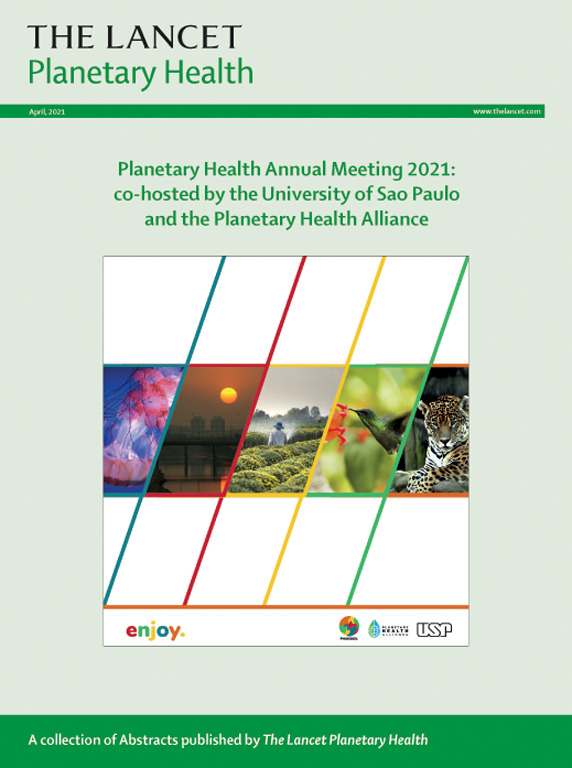Residential tree canopy configuration and mortality in 6 million Swiss adults: a longitudinal study
IF 24.1
1区 医学
Q1 ENVIRONMENTAL SCIENCES
引用次数: 0
Abstract
Background
Residential exposure to trees has been associated with reduced mortality risks. We hypothesise that in addition to tree canopy cover, tree canopy configuration also plays a role in exposure–mortality relationships. As there is limited evidence on this hypothesis, especially longitudinal evidence, we performed a nationwide study to investigate the residential tree canopy configuration–mortality associations in the Swiss population.
Methods
In this longitudinal study, the tree canopy cover and configuration metrics within 500 m of individuals’ residences were quantified using high-resolution tree canopy data (1 × 1 m) from 2010 to 2019. We developed single-exposure and multi-exposure time-varying Cox regression models to estimate the associations between the different exposure metrics and natural-cause and cause-specific mortality in Swiss adults (aged from 20 years to 90 years). Mortality and census data were taken from the Swiss National Cohort (SNC). We estimated the hazard ratios (HRs) and corresponding 95% CIs per IQR increase in the metrics adjusting for personal sociodemographic and contextual covariates. We also explored the effect modification by tree canopy cover, PM10, air temperature, urbanisation level, age, sex, and area-based local socioeconomic position.
Findings
Our analyses included 6 215 073 individuals from the SNC between 2010 and 2019. In the fully adjusted single-exposure models, we observed protective associations between natural-cause mortality risk and tree canopy cover (IQR 12·4%, HR 0·979 [95% CI 0·975–0·983]) and configuration metrics describing the aggregation (6·3%, 0·831 [0·823–0·840]), and connectedness (2·9%, 0·946 [0·938–0·953]); and detrimental associations with two metrics describing the fragmentation (211 patches per 100 ha, 1·073 [1·066–1·080]) and shape complexity (1·9, 1·094 [1·089–1·100]) of patches. The associations were generally preserved with other common causes of death. According to the multi-exposure models, the HR (95% CI) for the combination of one IQR decrease in aggregation and one IQR increase in fragmentation and shape complexity was 1·366 (1·343–1·390). Analyses on modification effects suggested a stronger association in people living in areas with a higher level of tree canopy cover, PM10 concentration, air temperature, and urbanisation level.
Interpretation
Aggregated, connected, and less fragmented forested greenspaces might offer stronger health benefits than isolated, fragmented ones, but are difficult to implement in cities. Our study provided valuable insights into optimising forested greenspaces and highlighted future directions for the planning and management of urban forests towards healthy and green cities.
Funding
National Research Foundation, Prime Minister's Office, Singapore under its Campus for Research Excellence and Technological Enterprise programme and ETH Zurich.
600万瑞士成年人的住宅树冠结构和死亡率:一项纵向研究
总统与树木的接触与降低死亡风险有关。我们假设,除了树冠覆盖,树冠结构也在暴露-死亡率关系中起作用。由于这一假设的证据有限,尤其是纵向证据,我们进行了一项全国性的研究,调查瑞士人口中住宅树冠构型与死亡率的关系。方法利用2010 - 2019年1 × 1 m的高分辨率树冠数据,对居民住宅500 m范围内的树冠覆盖度和构型指标进行量化研究。我们建立了单次暴露和多次暴露时变Cox回归模型,以估计不同暴露指标与瑞士成年人(年龄从20岁到90岁)自然原因和原因特异性死亡率之间的关系。死亡率和人口普查数据来自瑞士国家队列(SNC)。在调整个人社会人口学和背景协变量后,我们估计了每IQR增加的风险比(hr)和相应的95% ci。我们还探讨了树冠覆盖度、PM10、气温、城市化水平、年龄、性别和基于区域的当地社会经济地位对效果的影响。我们的分析包括2010年至2019年期间来自SNC的6215073人。在完全调整的单次暴露模型中,我们观察到自然原因死亡风险与树冠覆盖率(IQR为12.4%,HR为0.979 [95% CI为0.975 - 0.983])、描述聚集性的配置指标(6.3%,0.831[0.823 - 0.840])和连系性(2.9%,0.946[0.938 - 0.953])之间存在保护性关联;这与描述斑块破碎度(每100公顷211个斑块,1·073[1·066-1·080])和形状复杂性(1·9,1·094[1·089-1·100])的两个指标存在不利关联。这种联系通常与其他常见的死亡原因有关。根据多暴露模型,一个IQR的聚集性降低和一个IQR的破碎性和形状复杂性增加的组合的HR (95% CI)为1·366(1·343-1·390)。对改造效应的分析表明,居住在树冠覆盖率、PM10浓度、气温和城市化水平较高地区的人们与pm2.5的关联更强。与孤立的、碎片化的森林绿地相比,聚合的、连接的、碎片化程度较低的森林绿地可能提供更强的健康效益,但在城市中难以实施。我们的研究为优化森林绿地提供了宝贵的见解,并强调了未来城市森林规划和管理的方向,以实现健康和绿色的城市。新加坡总理办公室国家研究基金会,由其卓越研究和技术企业计划校园和苏黎世联邦理工学院资助。
本文章由计算机程序翻译,如有差异,请以英文原文为准。
求助全文
约1分钟内获得全文
求助全文
来源期刊

Lancet Planetary Health
Multiple-
CiteScore
28.40
自引率
2.30%
发文量
272
审稿时长
8 weeks
期刊介绍:
The Lancet Planetary Health is a gold Open Access journal dedicated to investigating and addressing the multifaceted determinants of healthy human civilizations and their impact on natural systems. Positioned as a key player in sustainable development, the journal covers a broad, interdisciplinary scope, encompassing areas such as poverty, nutrition, gender equity, water and sanitation, energy, economic growth, industrialization, inequality, urbanization, human consumption and production, climate change, ocean health, land use, peace, and justice.
With a commitment to publishing high-quality research, comment, and correspondence, it aims to be the leading journal for sustainable development in the face of unprecedented dangers and threats.
 求助内容:
求助内容: 应助结果提醒方式:
应助结果提醒方式:


